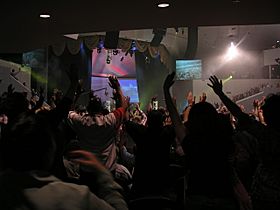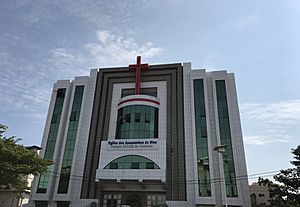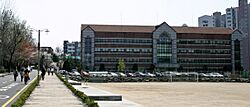Assemblies of God facts for kids
Quick facts for kids World Assemblies of God |
|
|---|---|

|
|
| Classification | Protestant |
| Orientation | Pentecostal |
| Theology | Finished Work Pentecostal |
| Governance | Cooperative body |
| Chairman | Dominic Yeo |
| Region | 190 countries |
| Origin | 1914 (WAGF formally established 1989) |
| Separated from | Church of God in Christ, Christian and Missionary Alliance, and various other denominations, including those of Reformed and Baptist traditions. |
| Merger of | Several Pentecostal groups |
| Separations | General Assembly of Apostolic Assemblies, The Foursquare Church |
| Congregations | 450,106 |
| Members | 86,143,293 |
| Aid organization | World Assemblies of God Relief and Development Agency |
The World Assemblies of God Fellowship (WAGF), often called the Assemblies of God (AG), is a large global group of Christian churches. It brings together over 170 different Pentecostal church groups from around the world. This fellowship was officially started on August 15, 1989.
The WAGF was created to help these churches work together more easily on a global scale. Before 1989, they were connected informally. The main goals of the WAGF include spreading the Christian message worldwide and helping people in need. They also work to share information and support theological education. Even though they work together, each church group in the WAGF is independent. They are united by shared Christian beliefs and history.
Contents
History of the Assemblies of God
How the Assemblies of God Started
Many church groups that are part of the WAGF have different beginnings. Most of them trace their roots back to the Azusa Street Revival. This was an important Christian revival that happened in Los Angeles, California, in the early 1900s. Other Pentecostal revivals around the world also played a role.
The largest member group, Assembleia de Deus in Brazil, began in 1911. It was first called Missão de Fé Apostólica. In 1918, its name changed to Assembleia de Deus.
The Assemblies of God USA was the first Pentecostal group to use the name "Assemblies of God." It was formed in April 1914. About 300 preachers and church members from many states and countries met in Hot Springs, Arkansas, USA. This meeting created a new fellowship. It was officially named the General Council of the Assemblies of God in the United States of America. Unlike other groups at the time, the Assemblies of God aimed to be a nationwide movement.
Growing Globally
Over time, new self-governing Assemblies of God groups formed in many countries. Some grew from local Pentecostal movements. Others started because of missionary work from the US fellowship. For example, Pentecostals in Canada formed the Pentecostal Assemblies of Canada in 1919. They officially joined with the Assemblies of God USA the next year.
The Assemblies of God in Great Britain started in 1924. This group influenced the Assemblies of God in Australia. Today, the Australian group is known as Australian Christian Churches. The Australian Assemblies of God formed in 1937. This happened when the Pentecostal Church of Australia and the Assemblies of God Queensland merged. The Assemblies of God of South Africa began in 1925.
Before 1967, the Assemblies of God USA, like many other Pentecostal groups, officially opposed Christians joining in war. They saw themselves as a peace church. Today, the US Assemblies of God still supports members who choose pacifism for religious reasons.
Through missionary work and building connections with other Pentecostal churches, the Assemblies of God grew into a worldwide movement. The global fellowship, the WAGF, was not formed until 1989.
In 1989, the different national Assemblies of God groups came together. This was thanks to Dr. J. Philip Hogan from the US Assemblies of God. The first goal was to coordinate spreading the Christian message. Soon, it became a more lasting way for the groups to work together.
Dr. Hogan was the first chairman of the Fellowship. He served until 1992. Then, Rev. David Yonggi Cho became chairman. In 1993, the group's name changed to the World Assemblies of God Fellowship. In 2000, Thomas E. Trask took over as chairman. At the 2008 World Congress in Lisbon, Portugal, George O. Wood was elected chairman. He was the General Superintendent of the Assemblies of God in the United States. In 2011, David Mohan became vice chairman. He was the General Superintendent of the All India Assemblies of God. Dominic Yeo from the Assemblies of God in Singapore was elected chairman in 2023.
Assemblies of God Statistics
The Assemblies of God is a very large Christian group. It has between 67 and 86 million members worldwide. A report from 2024 shows it has 450,106 churches. It also has 86.1 million members and people who attend its churches globally.
What the Assemblies of God Believes

The Assemblies of God has core beliefs that are part of the Pentecostal and evangelical Christian traditions. They believe in the Trinity, meaning God exists as the Father, Son (Jesus), and Holy Spirit. They also believe the Bible is inspired by God. They see it as the true guide for faith and how to live.
They practice Baptism by immersion for those who have chosen to follow Jesus. This baptism is a public sign of an inner change. It shows a person has moved from a life of sin to a new life in Christ. They also celebrate Communion. This is a special meal where bread and juice are shared. These items are symbols that remind them of Jesus' suffering and death. They also look forward to His return. The Assemblies of God strongly believes in the Great Commission. This is the idea that Christians should share their faith with people all over the world.
As Pentecostals, the Assemblies of God believes all Christians should seek baptism in the Holy Spirit. They teach that this experience is separate from becoming a Christian. It gives believers power for their Christian life and service. The first sign of being baptized in the Holy Spirit is often speaking in tongues. This means speaking in a language that the person has not learned. They also believe in other spiritual gifts today, like divine healing.
The Assemblies of God allows women to become pastors. This is a common practice among Pentecostal and Charismatic churches.
The World AG Fellowship has a statement of faith. This outlines the main beliefs that connect all the different groups. However, each national Assemblies of God group also has its own specific beliefs. For example, the Assemblies of God USA follows its own Assemblies of God Statement of Fundamental Truths.
Assemblies of God and Politics
Some members of the Assemblies of God are involved in politics. For example, Scott Morrison was a former prime minister of Australia. He has stated that the Bible is not a policy book. He also said he would support religious freedom more strongly.
In Brazil, the local group Assembleias de Deus has become more involved in politics. Some of its members have held political positions. For example, Marina Silva is a Brazilian politician and an AG member. She supports environmental ideas and the rights of indigenous tribes. The church leadership has sometimes disagreed with her views on certain issues.
In the United States of America, most Assemblies of God members tend to support the Republican Party. During Donald Trump's time as president, the General Superintendent, George O. Wood, attended a National Day of Prayer. He spoke positively about an order that allowed religious groups to support political candidates.
How the Assemblies of God is Organized
The World Fellowship brings together national Assemblies of God councils from around the world. This helps them work together. Each national council is fully independent and governs itself. Being part of the World Fellowship does not limit this independence.
The work of the World Fellowship is managed by the Executive Council. Members of this council represent different parts of the world. They serve for three years. Regions like Africa, Asia Pacific, Latin America/Caribbean, and North America each have four representatives. Europe has three, and the Middle East and Southern Asia each have one. These members are chosen by the General Assembly. Each World Fellowship member can send delegates to the General Assembly. Each member group gets one vote. The General Assembly also chooses the Chairman, Vice Chairman, and Secretary of the World Fellowship.
At both national and local levels, the Assemblies of God churches are usually organized in a way that combines local church independence with oversight from district and national councils.
The World Assemblies of God Relief Agency (WAGRA) handles the humanitarian work of the fellowship. This includes helping people in need around the world.
See also
 In Spanish: Asambleas de Dios para niños
In Spanish: Asambleas de Dios para niños
- Assembleias de Deus (in Brazil)
- List of Assemblies of God National Fellowships
- List of Assemblies of God schools
- List of Assemblies of God people
- World Evangelical Alliance



